The Time Travelers' Handbook (7 page)
Read The Time Travelers' Handbook Online
Authors: Lottie Stride



In front of you appears a man with a pointy beard and a twirly mustache. He is pacing around, tugging at his hair, and muttering to himself. You have landed backstage at the Globe Theatre in London, and this is William Shakespeare, who will become probably the most famous playwright in history.
Right now, however, Shakespeare's in trouble. Halfway through a performance of his new play, one of his actors has rushed offstage. The boy has a green face, he's holding his stomach, and groaning about eating one too many eel pies.
The Show Must Go On
Just then, Will spots you and decides you'd be the perfect replacement. Before you know it, he's shoving a script in your hand and giving you a few acting tips:
⢠Speak up. The audience sitting up in the highest gallery are a long way away. If you breathe in from just above your belly button and fill up with air, your voice will be much stronger and travel much farther without needing to shout.
⢠Speak clearly. Pronounce your words more precisely than you would normally. If you talk too quickly or slur your words, the audience won't be able to understand you and will get bored.
⢠Look around. The Globe Theatre is circular and the audience is on three sides of the stage, so you need to move your body so you can be seen by everyone.
If you follow these tips, hopefully, the 3,000-strong audience won't get bored. If they do, watch out. Rowdy Elizabethan audiences will throw things. If you see any food flying through the airâduck, or you could get a rotten turnip in the face.

How To Stage A Fight
William Shakespeare has written plays about love, war, witches, murders, ghosts, and shipwrecksâanything to keep his audience interested. He loves to write about fights. The play is
Macbeth
and has a great fight scene. William quickly tells you how to stage a fight so you can take part in the play onstage right now.
Every single move in a stage fight is planned out and rehearsed over and over again. Read his tips and practice with a friend:
1.
Arm yourselves. Remember that the whole point of your stage fight is that neither of you gets hurt. So, choose your weapons carefully. The long cardboard tubes you get in wrapping paper are ideal.
2.
Decide why you are fighting. This will provide drama. Perhaps one of you is the king and the other is wanting to steal his throne, or you could be pirates fighting over a pot of gold.
3.
Find a good place to rehearse, like a yard or park, then you can start to create your fight.
4.
Be entertaining. If you both just go
whack, whack, whack
with the swords, it will be boring. Swing around things. Jump off things. Use props: Maybe one of you can drop his sword and be forced to use something else to fight with. Be inventive.
5.
Once you have worked out your moves, rehearse them slowly at first until you are sure you both know them in the right order. Then speed them up, and gradually work the fight up to full speed.
Top Tip:
Don't forget the sound effects. Grunts, gasps, and shouts are all good. To make it sound really authentic, say things like “Alack!” or “I'm slain.” Dying scenes should be as long and drawn out as possible.

The two men in front of you are a fierce and terrifying sight, clad in strange armor, with wide helmets, and each holding a long, curved sword. They are samurai, members of a group of ancient Japanese warriors who ruled Japan for 700 years. Samurai warriors are considered to be some of the greatest swordsmen in history. Luckily for you, however, they follow a strict code of honorâand that includes not attacking an unarmed time traveler who is considerably shorter than they are.
Your new samurai friends are also extremely polite. They bow and present their beautiful swords for you to look at. Samurai swords are called
katana
and can take many months to make. They are formed from steel that is heated and then folded over and over again to make it very strong and flexible. As a result, the swords are very valuable. Swords are given names, such as “billowing waves” and “cherry blossom.” The names are inspired by a wavy line called the hamon line on the blade of each sword, caused by the joining of the steel. The swords are very sharp and can slice a man in two so quickly that he will continue to walk for several paces before falling down dead.

The two warriors invite you to watch them practicing their sword skills. They move so fast and nimbly, your eyeballs ache keeping up. The clanging, swishing, slicing sound coming from their swords makes one thing clear: You know whose side you'd want to be on in a battleâtheirs.
Warrior Ways
You'd love to stay and watch, but a young samurai who is about your age whisks you away. He is learning a martial art called
kendo
, which means “the way of the sword,” but he is late because his partner has not turned up, so you agree to go with him.
You join a group of boys. Each has a bamboo stick, which he holds with both hands. Grabbing a spare stick from the side of the room, you move to a position where you can watch the teacher at the front of the group.
You notice that, unlike a modern classroom, everyone here is very well behaved. This is because the samurai live by a code called
Bushido
âwhich means “the way of the warrior.” They value obedience, self-discipline, and bravery above all things. Your friend tells you that the word
samurai
means “one who serves”ânot one who whispers and passes notes at the back of the class.
Kendo
is performed with a partner, who is referred to as
motodachi
. The class splits into pairs, so you stand opposite your friend. The first part of the practice involves a special ceremony:
1.
Stand opposite your
motodachi
, about nine paces apart. Hold your stick, called
shinai
, on your left-hand side if you are right handed, or on your right-hand side if you are left handed.
2.
Lift your
shinai
to hip level, and take three steps toward your partner.
3.
On the third step, lift your
shinai
up and forward. Your partner should do exactly the same. Hold your
shinai
so the tips are almost touching.
4.
Move your left foot so the heels of both your feet are almost touching.
5.
Bend your knees and go into a deep squat, spreading your knees wide apart. This is called
sonkyo
.
6.
Stand up.
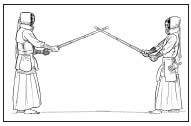
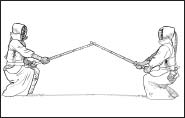
Unfortunately, your knees make a large cracking sound as you squat and you get the giggles. The teacher looks very angry with you, so perhaps it is time to leave. Press EJECT.

You've touched down on the coast of Norway during the age of the Vikings. The Vikings are explorers, warriors, and merchants who lived in what is now known as Scandinavia.
You seem to be in a long hut surrounded by several women who are hard at work, sewing together pieces of linen to make a large, square shape. One of them hands you a needle and thread. At that moment, a huge man walks into the hut and saves you from sewing.
The man, who is called Olaf, takes you outside, where dozens of people are busy building a magnificent ship. It is almost ready to set sail. As he walks you around, Olaf tells you exactly what the workers have done so you can try to build your own longship.

Longships can be as long as 100 feet, so you will need to chop down a very tall tree to form the ship's keelâthe long central piece that runs all the way along the bottom of the ship. Attach large, curved pieces of wood to each end of the keel to form the front and back of the ship, known as the bow and the stern.
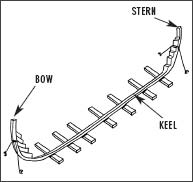
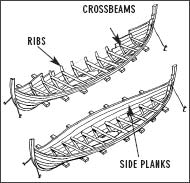
Fix support planks, called ribs and crossbeams, at right angles to the keel. Take some sturdy side planks and attach them from the bow to stern to form the sides and bottom of the ship. Each plank should overlap the one below it and be fixed in place with iron rivets. Add a large block of wood to support the mast.
Lay smooth planks over the crossbeams to form the deck. Fix a large, fish-shaped piece of wood onto the deck for the mast to slip through. This is called the
kløften.
Add trestles, to hold the sail when it is lowered.
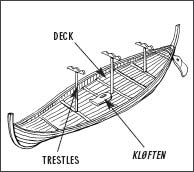
Drill holes in the side of the ship for the long, thin oars to poke through. At the stern of the boat, add a large steering oar. Make sure you make some disks of wood that can fit over the holes to stop water getting in when the oars aren't being used.
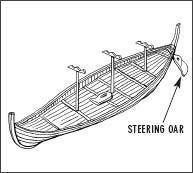

To make your ship seaworthy, you need to caulk it. Get some animal fur and dip it into hot tar. The tar is smelly stuff but it will make your ship waterproof. Push your tar-soaked wads of fur between the planks of the ship, making sure there are no gaps.
Olaf tells you he is going to call his ship the
Sea Dragon
. He leads you to a skilled carpenter who is carving a fearsome dragon's head to mount on the bow of the boat.

He invites you to join his voyage, but the deck looks like it will be quite crowded with all those big strong Vikings on board. What's more, pulling the ship's heavy oars doesn't look like fun. So, you wave them off on their way from the shore, and hit the EJECT button.
